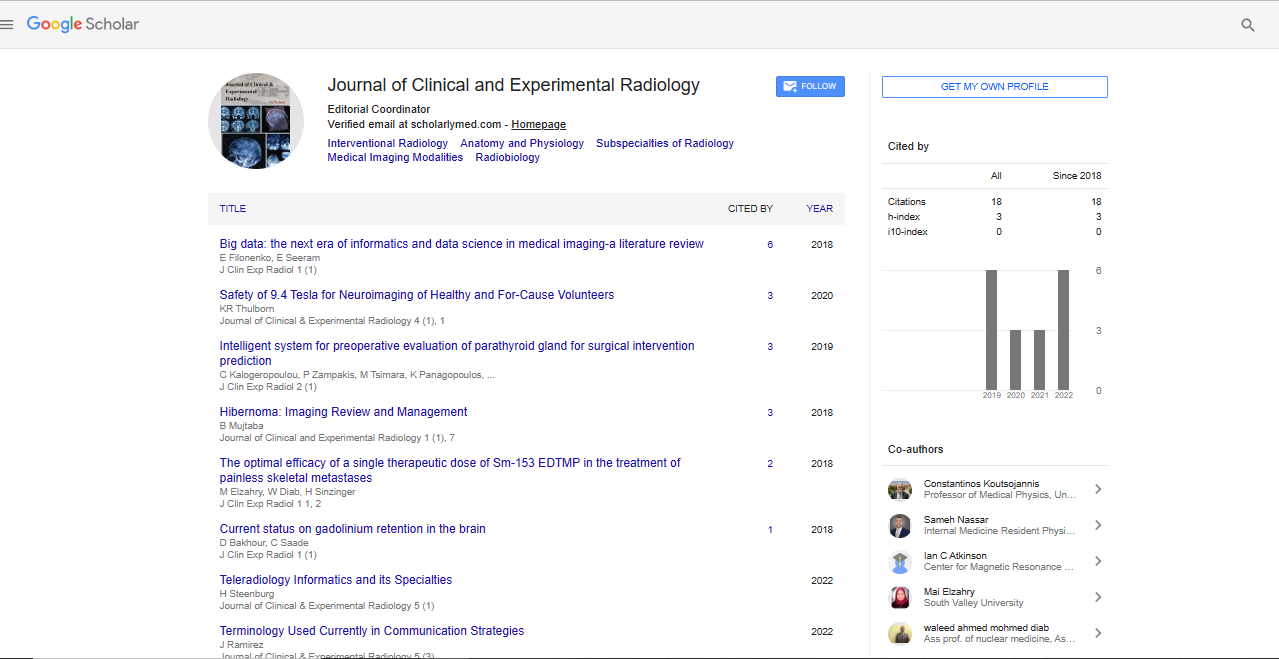Opinion Article, J Clin Exp Radiol Vol: 6 Issue: 4
Illuminating Insights: A Comprehensive Exploration of Diagnostic Imaging
Yieng Wiang*
1Department of Radiology, Affiliated Hospital of Jianghan University, Wuhan, China
*Corresponding Author: Yieng Wiang,
Department of Radiology, Affiliated Hospital
of Jianghan University, Wuhan, China
E-mail: yiengi@gmail.com
Received Date: 24 November, 2023, Manuscript No. JCER-24-124143;
Editor assigned Date: 27 November, 2023, PreQC No. JCER-24-124143 (PQ);
Reviewed Date: 13 December, 2023, QC No. JCER-24-124143;
Revised Date: 20 December, 2023, Manuscript No. JCER-24-124143 (R);
Published Date: 27 December, 2023, DOI: 10.4172/jcer.1000151
Citation: Wiang Y (2023) Illuminating Insights: A Comprehensive Exploration of Diagnostic Imaging. J Clin Exp Radiol 6:4.
Description
Diagnostic imaging stands as a beacon in modern healthcare, providing clinicians with powerful tools to peer inside the human body and expose the mysteries of health and disease. This manuscript searches into the multifaceted world of diagnostic imaging, resolving its diverse modalities, technological advancements, and transformative impact on medical diagnosis and patient care.
The evolution of diagnostic imaging
Radiography and the birth of medical imaging: The journey of diagnostic imaging began with the discovery of X-rays by Wilhelm Roentgen in 1895. Radiography, the use of X-rays to create images of the internal structures of the body, marked the inception of medical imaging, offering a non-invasive means to visualize bones and tissues.
Advancements in Computed Tomography (CT): The evolution of diagnostic imaging continued with the advent of computed tomography in the 1970s. CT scans provide cross-sectional images of the body, offering enhanced clarity and detail compared to traditional X-rays. This technological leap allowed for the visualization of soft tissues and organs with unprecedented precision.
Magnetic Resonance Imaging (mri) and beyond
Revolutionizing imaging with MRI: Magnetic Resonance Imaging, introduced in the 1980s, harnessed the power of magnetic fields and radiofrequency pulses to generate detailed images of soft tissues, organs, and the central nervous system. MRI's ability to produce images without ionizing radiation made it a valuable complement to other imaging modalities.
Nuclear medicine and Positron Emission Tomography (PET): Nuclear medicine techniques, including PET scans, emerged as powerful tools to visualize physiological processes at the molecular level. By introducing radioactive tracers, PET scans enable the imaging of metabolic activity, providing crucial insights into conditions such as cancer and neurological disorders.
Ultrasound and fluoroscopy
Dynamic imaging with ultrasound: Ultrasound, utilizing sound waves to create real-time images, became a versatile diagnostic tool.
Beyond its role in obstetrics, ultrasound enables dynamic imaging of organs, vessels, and soft tissues, aiding in the diagnosis of various medical conditions.
Fluoroscopy for real-time visualization: Fluoroscopy involves continuous X-ray imaging to capture real-time, dynamic images of internal structures. It plays a pivotal role in procedures such as angiography and gastrointestinal studies, providing valuable information for both diagnosis and intervention.
Technological innovations and 3d imaging
Digital radiography and 3d reconstruction: Digital radiography transformed the traditional film-based approach, allowing for faster image acquisition and enhanced image manipulation. The integration of 3D reconstruction techniques further expanded diagnostic capabilities, enabling a more comprehensive understanding of complex anatomical structures.
Artificial intelligence in diagnostic imaging: The integration of Artificial Intelligence (AI) in diagnostic imaging represents a paradigm shift. AI algorithms analyze vast datasets, aiding in image interpretation, pattern recognition, and the detection of subtle abnormalities. This holds the potential to enhance diagnostic accuracy and efficiency.
Multimodal imaging and fusion techniques
Integration of multiple modalities: Multimodal imaging involves combining information from different imaging modalities to obtain a more comprehensive view of the anatomy and pathology. Techniques like PET-CT fusion provide both anatomical and functional information, aiding in precise localization and characterization of abnormalities.
Fusion imaging in interventional procedures: Fusion imaging extends its utility to interventional procedures, guiding clinicians with real-time imaging during surgeries, biopsies, and other interventions. This integration enhances precision, minimizes invasiveness, and contributes to improved patient outcomes.
Challenges and ethical considerations
Radiation exposure and dose management: Despite its numerous benefits, diagnostic imaging raises concerns about ionizing radiation exposure. Dose management strategies, including dose optimization and justification, are critical to balancing the diagnostic benefits with potential risks.
Ethical considerations in imaging: Ethical considerations surround issues such as patient consent, privacy, and the responsible use of imaging technologies. Striking a balance between obtaining necessary diagnostic information and safeguarding patient rights remains a paramount concern in the evolving landscape of diagnostic imaging.
Conclusion
Diagnostic imaging, with its myriad modalities and technological innovations, continues to redefine the landscape of medical diagnosis and patient care. From the discovery of X-rays to the integration of AI, each milestone has contributed to the evolution of this indispensable field. As diagnostic imaging advances further, the quest for precision, accessibility, and ethical practice remains at the forefront, ensuring that this radiant journey continues to illuminate the path to better healthcare and improved patient outcomes.
 Spanish
Spanish  Chinese
Chinese  Russian
Russian  German
German  French
French  Japanese
Japanese  Portuguese
Portuguese  Hindi
Hindi 